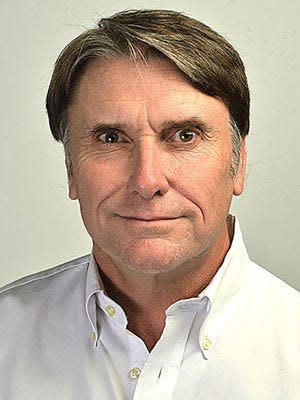'Labor is Life' or 'Workers of the world, unite'? Future of capitalism lies in the middle
- Oops!Something went wrong.Please try again later.
- Oops!Something went wrong.Please try again later.
Sometimes social media can be unintentionally profound. Maybe the only time it is profound is when it’s unintended.
On Monday, two images appeared back to back in my Twitter feed, both posted in celebration of Labor Day. The first was of the 1956 postage stamp commemorating labor, the second a Rockwell Kent engraving commemorating the same subject. The similarities ended there.

The postage stamp features a well-muscled young man gazing heroically into the distance as his wife teaches their boy to read. On his shoulder he carries a pick, an ax and a sledge hammer, all decorated with brocade and oak leaves. In the corner was a quote by the philosopher Thomas Carlyle, “Labor is Life.”
#OTD in 1956: Labor Is Life
‘Labor Day. Labor is life -Carlyle’ 3-cent US postage stamp issued Sept. 3, 1956
Designed by Victor S. McCloskey, Jr. of the Bureau of Engraving & Printing.#PostageStamps #stamps #USPS #SaveTheUSPS #LaborDay #Labor pic.twitter.com/chDnLkeDxc— Voli pindarici - Pindaric flights (@LRonLacy) September 3, 2022
The inspiration for the engraving was a mural by Lumen M. Winter, who designed it for the AFL-CIO’s Washington, D.C., headquarters.
Kent’s work was produced 19 years earlier, not for the United States Postal Service, but for the left-wing magazine “New Masses.” In it, a barefooted worker wields a shovel against unseen enemies, only the points of their sabres visible. Smoke billows in the background, fires rage and an endless string of smokestacks spit inky soot.
Workers of the World, Unite!
Rockwell Kent, 1937.
Wood engraving; 14.9 x 20.1 cm.
A life-long pacifist dedicated to socialist causes, the artist expressed his proletarian beliefs in Workers of the World Unite!, a wood engraving of an idealized laborer wielding a shovel. pic.twitter.com/Hy70d31JxY— 💀ɹɟpzʍ◉⃤ (@rfdzw) September 6, 2022
Oak leaves and brocades are not to be seen. Nor is there a reference to labor being life; instead, the title is the Marxist catchphrase, “Workers of the World, Unite.”
All told, it is difficult to think of two depictions of the same thing being more different. In both, the worker is the champion, but in Winter’s, the man is heroic because of work, in Kent’s, in spite of it.
Winter was not out to make a political statement as such, but to celebrate an American ideal. Be strong, work hard, don’t make a fuss and you will be rewarded with a devoted wife, a stable home, and children who have the opportunities for an education and a better life than yours.
This would have been recognizable to workers in the 1950s, who came home from World War II to find plentiful and well-compensated jobs in the factories and mills across the land. This was in the wheelhouse of Winter, whose works typically celebrated American can-doism. His works commemorated U.S. Savings Bonds, FDR’s New Deal and human flight.
But it is the quote from Carlyle that is perhaps the most interesting and provocative. As a “sound bite” it worked, but Carlyle was no champion of the “little people.” He celebrated great, heroic figures, including the “captains of industry” who have often been the bane of the common workers’ existence.
His subjects, including Frederick the Great, early Norwegian Kings and Sir Robert Peel, were fascinating, but they were hardly Tom Joad.
Nor did he have use for democracy. “Find in any country the Ablest Man that exists there; raise him to the supreme place, and loyally reverence him,” he suggested. “You have a perfect government for that country; no ballot-box, parliamentary eloquence, voting, constitution-building, or other machinery whatsoever can improve it a whit.”
More local news:Where will we teach the kids? The math about classroom space and new housing development
Carlyle was complex to the point of incomprehensibility. He admired the capitalists, his “captains of industry,” but not capitalism. He was, perhaps, the first to espouse the “dignity of work,” but that dignity did not include a living wage. Instead, he seemed to suggest that the honor and glory of labor was reward enough. His captains of industry were to see to their employees’ well-being because, of course, looking out for their employees’ interests is what all good CEOs do.
If Carlyle was sometimes branded a fascist, Rockwell Kent was at the other end of the spectrum, a proud socialist who became so irritated with his own country that he boxed up many of his best works and shipped them to the Soviet Union.
Kent didn’t just believe in the dignity of work for others, he practiced it. He was a dynamo who, along with his art, built his own houses, established a productive dairy farm, obsessively visited barren wildlands and went through wives and lovers like Kleenex.
Always prescient, he saw World War II coming while the world’s diplomats were whistling past the graveyard. His laborer in “Workers of the World, Unite” is fighting the flames of capitalism, understanding that Carlyle’s benevolent overlords are a fantasy.
More local news:Is Washington County becoming a hub for sex trafficking?
It is curious that Kent and Carlyle both mistrusted capitalism, though for entirely different reasons. In Carlyle’s world, the proletariat was afforded too much consideration, in Kent’s, too little.
Industrial captains in the form of the robber barons dominated the Industrial Revolution; workers had their day in the heart of the 20th century. Corporate CEOs had regained the upper hand until COVID-19 changed the worker-employer dynamic yet again.
Is there a middle ground between Kent’s and Carlyle’s viewpoints, where employee and employer share their productivity in harmony? The answer may ultimately decide whether capitalism as we know it lives or dies.
Tim Rowland is a Herald-Mail columnist.
This article originally appeared on The Herald-Mail: Where do employee and employer share productivity in harmony?
